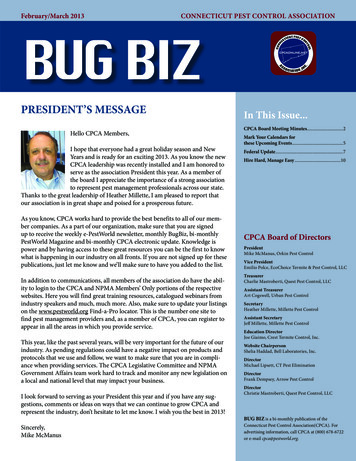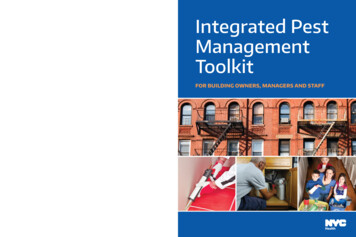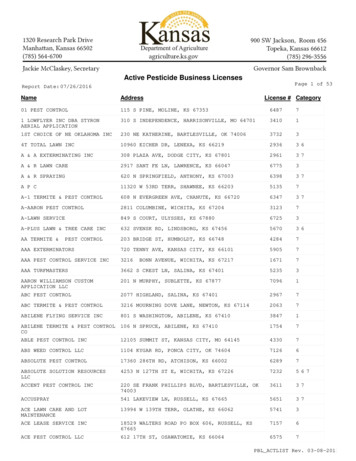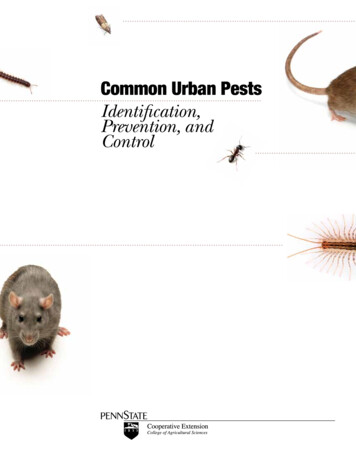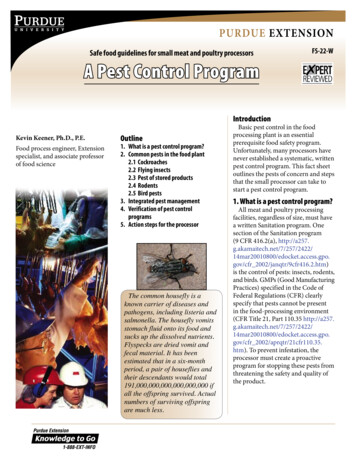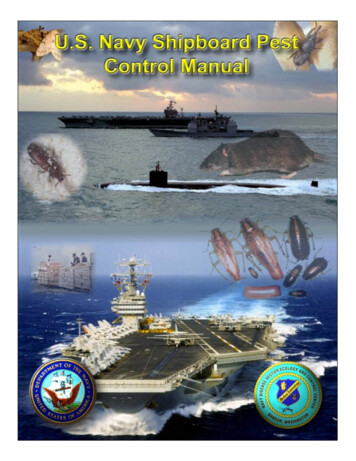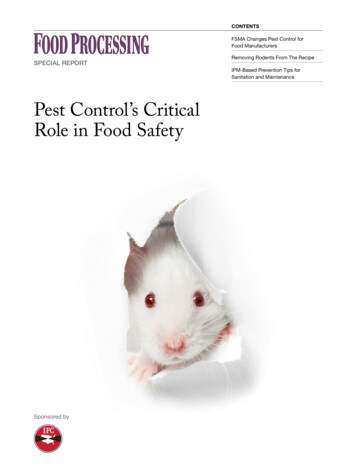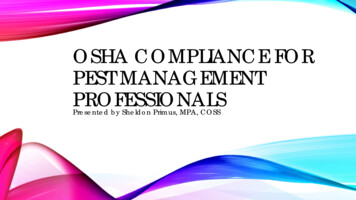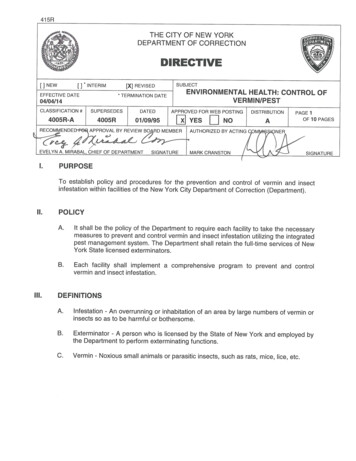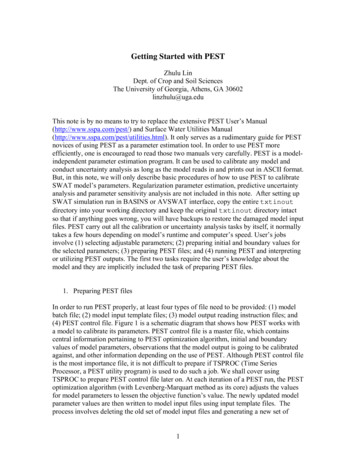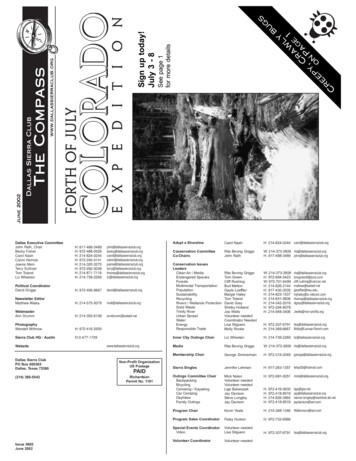
Transcription
STATE PEST CONTROL REGULATORY OFFICIALS CONFERENCE (SPECROC)HISTORICAL URER:LOCATION OF ANNUAL MEETING:DATE:Wichita, KS9/23/70 to 9/24/70HIGHLIGHTS OF MEETING:**Legislative and regulatory concerns of the structural pest controlindustry (Dr. Ralph Heal, NPCA).**Review of insurance and bond requirements of all states (Macon Bonner,Califormia).**Progress report from the US Forest Service Wood Products InsectLaboratory (H.R. Johnston, MS)** State Reports** Field trip to Wood Products Insect Laboratory, Gulfport, MS.RESOLUTIONS:NONE IN HISTORICAL RECORDMISC: Historical records contain the minutes of the meeting.H. Dean Garwood, Kansas, presided over the meeting.**Paper on Bonds and Insurance Requirements of those states with licensedpest control operators.**States participating in the meeting were Arizona, California, Florida,Kansas, Louisiana, Michigan, Mississippi, Missouri, New Jersey,North Carolina, Oklahoma, South Carolina, and Tennessee.**Roster of the State Pest Control Regulatory Officials Conference(SPECROC)
The Eleventh Annual Conference of the National Association of Pest ControlRegulatory Officials (formerly State ;Fest Control Regulatory OfficialsConference) met at the Holiday Inn Plaza in Wichita, Kansas on September 23and 24, 1970, The conference was well attended and highly beneficial in termsof information exchanged, program excellence and objectives accomplished.The meeting sessions were presided over by Mr. H. Dean Garwood, Director,Division of Entomology, Kansas State Board of Agriculture of our host state.The states represented at this conference were: Arizona, California,Florida, Kansas, Louisiana, Michigan, Mississippi, Missouri, New Jersey,North Carolina, Oklahoma, South Carolina and Tennessee.Program of theNational Association of Pest Control Regulatory Officials23 and 24 September 1970Wednesday Morning 23 SeptemberRegistrationWelcome to Wichita and Kansas - H. Dean Garwood and The Honorable A. PriceWoodard, Mayor of the City of Wichita.Reports from the States: North Carolina, Rudy E. Howell; Florida, F. R.Du Chanois; Kansas, H. Dean Garwood; Wichita, Kansas, Rudy Betts; Louisiana,Richard Carlton; South Carolina, D. M. Gayden.Legislative and Regulatory Concerns of the Structural Pest Control Industry Dr. Ralph E. Heal, Executive Secretary, National Pest Control Association.Reports from the States (cont.): California, Macon Bonner; Missouri, Don F.Courtney; Michigan, John C. Dreves; Tennessee, C. E. Turner; Oklahoma,H. H. Latham; Mississippi, Robert McCarty.Review of Insurance and Bond Requirements of All States - Macon Bonner, Registrar,Structural Pest Control Board, California Department of Professional andVocational Standards.Thursday Morning, 24 SeptemberProgress Report from U.S. Forest Service Wood Products Insect Laboratory H. R. Johnston, Project Leader, USDA, Forest Service, Wood Products InsectLaboratory, Gulfport, Mississippi.Law Enforcement Panel - Mr. Harold Nye, Director, Kansas Bureau of Investigationand Mr. Dan Metz, County Attorney and Prosecutor, Lincoln County, Kansas.Business Session - Hr. H. Dean Garwood, Chairman.Adjournment
STATE OFFLORIDAEMMETT S . ROBERTSREUBIN O ' D. ASKEWSECRETARYGOVERNORDEPARTMENT of HEALTH and REHABILITATIVE SERVICES30 July 1971DIVISION OF HEALTHWILSON T. SOWDER, M . O., M . P . H., DIRECTORBOX 21(1---JACKSONVILLE 32201-TEL. 904 - 354-3961MEMORANDUM:TO:National Association of Pest Control Regulatory Officials -- Al l MembersFROM:F. R. Du Chanois, Secretary, FloridaSUBJ:Minutes and Notes of 11th Annual Conference in Wichita , KansasThe Eleventh Annual Conference of the National Association of Pest Control Regulatory Officials (formerly State Pest Control Regulatory Officials Conference) met atthe Holiday Inn Plaza in Wichita , Kansas on 23 and 24 September 1970. The conferencewas well attended and highly beneficial in terms of information exchanged , programexcellence, and objectives accomplished. The meeting sessions were capably presidedover by Mr. H. Dean Garwood , Director, Division of Entomology , Kansas State Boa r d ofAgriculture, of our host state;Minutes and Notes of the Eleventh Annual Meeting*NATIONAL ASSOCIATION OF PEST CONTROL REGULATORY OFFICIALSWichita, Kansas23 and 24 September 1970Wednesday Morning, 23 SeptemberREG I STRATI ONWELCQME TO WICHITA AND KANSASMr. H. Dean Garwood opened the meeting and welcomed members to the Sunflower State ,the Great State of Kansas.The Honorable A. Price Woodard, Mayor of the City of Wichita, welcomed the membersto Wichita.There were 22 persons in attendance at the opening session and 27 at later sessions.The following states were represented at the Conference: Ar i zona , California, Florida,Kansas, Louisiana, Michigan, Mississippi, Missouri, New Jersey (by Dr. Ralph E. Heal),North Carolina, Oklahoma, South Carol i na and Tennessee.*For information and us of NAPCRO members only. Information presented herein reflectsopinions of individuals and not the Association. It is believed to be correct andinaccuracies or omissions are unintentional. Corrections will gladly be made in thenext issue upon request.ADVISORY COUNCIL -9- E. COLEMAN BREWER, PH.G., MemberJ. M. COHEN, D.O. , MemberEUGE NE G. PEEK, Jr. , M.D., PresidentWILLIAM FREDERICK LINDSEY, M.D., MemberWILLIAM J. WEBER, D.V.M., MemberA. B. GALLOWAY, D.D.S., Member
-2-RE PORTS FROM TH E STATESNo r th Ca ro l ina (Mr. Rudy E. Howe! 1): Structural Pest Control Commission was abolisheda nd replaced with Structural Pest Control Board (SPCB) functioning under StructuralPest Con t rol Division of State Department of Agriculture. Minimum standards wererev i sed to require that piers, chimney bases, and foundation walls over eight inches int hi c kness be drilled. Those less than eight inches thick need not be drilled but mustbe t r eated to footing. They now accept rodding/drilling of porches vice excavation/t unneling. Aldrin , dieldrin and h ptachlor (0.5%) and chlordane (1.0%) are acceptedfo r subterranean termite control. Chlordane (1.0%) and dieldrin (0.5%) are acceptedror powde r -post beetle control. New regulations become effective 1 January 1971.North Carolina licensed 251 pest control operators in 1970 in one or more oft hr ee categories : fumigation, general household pests, and term i tes. The state hassix inspectors. Mr. Howell serves as Director of the Structural Pest Control Divisionand Secretary to the SPCB. He presented data on their pre-treatment soil samplingpr og ram in which they use the USDA-FHA methodl/, A copy of this method is availablef rom the Secretary on request. They obtain results which compare favorably with thoseob t ained from gas chromatography. The more the method is used the more val id andreliable the results. They impose a 10.00 fine on the licensee for each propertywhen the treatment is deficient. They are now starting to check existing structures.A composite of ten pooled samples per structure is used in tests .Florida (F. R. Du Chanois): Reviewed their 1969-70 year briefly. There were nochanges in the Florida Pest Control Act or regulations during 1970. A five man PestCon trol Adviso ry Council composed of the Chairman of the Entomology Dept., Universityof Fl orida , a member representing the pesticide manufacturers' industry, and threepest control operators representing the three state trade associations, was appoi tedby the Secretary of the Department of Health and Rehabilitative Services (which includest he Divis i on of Health), and functions to advise the Division on matters affectingcommercial pest control throughout the state.It was explained that "Restricted Pesticides" under an amendment to the FloridaPes t icide Law may be purchased or used only under an annual perm i t issued by theComm i ssioner of Agriculture and Consumer Services or by a licensed (structural) pestcontrol fi rm. 11 Persistent Pesticides" are carefully controlled, not banned, byre cent legislation to take effect 1 Jan. 1971.Ka nsas (Mr. H. Dean Garwood): Reported there was no change in Kansas pest controllaw in 1969-70. A Pest i cide Use Act was passed in the last session of the StateLegis l ature ; however, it exempts the pest control industry. They contemplate amendingtheir law to provide more revenue for administration/enforcement of the law. There cent trend in Kansas is toward greater restrictions/control in use of pesticidesrather than banning pesticides.Wi ch ita , Kansas (Mr. Rudy Betts): Mr. Betts represented the City of Wichita PestControl Regulating and Examining Board. He commented on change of attitude in theindustry i n terms of greater spirit of cooperation and a desire to become bettereducated and tra i ned. Made the point, well taken, that the industry and regulatoryagencies need each othe r . The anti-pollution campaign has motivated the undustry towan t and to seek out more information and education. Wichita's Licensing and ExaminingBoard comes under the County Health Department.1/ Chisholm , Koblitsky and Westlake-. The e timation of aldrin ahd chlordane in soilst reat ed fo r term i te control. USDA, ARS-33 73, Jun. 1962.
-4power to adopt regutations. They have instituted three-day training course in Scientific Pest Control sponsored by Mississippi Pest Control Operators' Association.State Plant Board inspectors assist as instructors. There is 50.00 fee for thecourse of 20 three-hour sessions. They are also planning one-day meetings for servicemen in various locations in state. Is very encouraged by the results so far.Mr. Mc Carty proposed a resolution be sent to Pesticide Regulation Division (nowE.P.A.), Washington, D.C. supporting the continued use of aldrin, chlordane, dieldrinand heptachlor for termite control. (See minutes of Business Session following).Louisiana (Mr. Richard Carlton): Described provisions and functioning of LouisianaPest Control Law. Their inspectors take samples of termite control chemical fromoperator's tank and check rate of application of pump. First time violations receiveone year probation, second violations are subject to one year suspension of I icense,and third violations result in revocation of license. Licensee's employees must beregistered within one month of employment. District Attorneys prosecute illegaloperators. Their Commission has injunctive powers. 11 Call offices 11 which have beenauthorized are being phased out over a four-year period as not being in the public'sbest interest.South CarolinaControl Law.(Mr. D. M. Gaydon):South Carolina does not have a Structural PestLEGISLATIVE AND REGULATORY CONCERNS OF THE STRUCTURAL PEST CONTROL INDUSTRYDr. Ralph E. Heal, Executive Secretary, National Pest Control Association(1)Federal Legislative ActionsThere is a batch of bills before the U.S. Congress to ban 7,8 or 9 pesticides essential to industry uses, such as aldrin, chlordane, DDT, dieldrin and heptachlor. Al I bills were referred to congressional Committees on Agriculture wherethey were receiving little attention (at the time). One bill calls for standards ofbiodegradability and toxicity by 30 June 1973. Much back scratching of conservationists,ecologists and salvationists is going on. Letter from NPCA to USDA states unequivocally that we are going to need many of the persistent pesticides for several yearsuntil there is an alternative available and registered (especially termite toxicants).(2) Regulatory Actions: Pesticides Regulation Division (now under EnvironmentalProtection Agency), U.S. Department of Agriculture under Federal Insecticide, Fungicide and Rodenticide Act (FIFRA).Dr. Heal made appeal for continued use of DDT for control of bats and mice inbuildings. Nothing available to replace the safety in use of DDT for mouse controlin ghetto areas and in public health interests and programs. U.S. Public HealthService (PHS) no longer promotes public health importance of roaches, mice, bats,rats. Communicable Disease Center reportedly said it knew of no public health use ofDDT; mice of no public health importance in ghettos. PHS has now approved DDT use forbats; is (was) pending before USDA (now EPA) for seal of approva 1.NPCA has submitted a statement supporting continued use of aldrin and dieldrinand will do so for chlordane and heptachlor. Mentioned no soil movement of thesematerials. There is tendency of regulatory people wanting to pass responsibility onto others, e.g. state regulatory authorities, NPCA. There is an apparent philosophythat all evils could be cured if pesticides were registered for use only by licensed
-· 3Mr. Garwood added that it supplements the State Pest Control Law program and istied in with the city occupational license and fee.California (Mr. Macon Bonner): Reported that California requires reports of type andamount of pesticides used in each county under new (State Dept. of Agriculture)Pesticide Use and Appl !cation Act which includes structural pest control licensees.They have gone to monthly exams because of problem of rec r uitment of qua] ified personsin California. They have successfully used an informal complaint system utilizing an''Informal Complaint For '. The Division of Investigation handles the Structural PestControl Board's investigations. The former Division now has five investigators whoare technically trained (in structural pest control field). The i nvestigator reportsviolations. These are referred to the Attorney General's Office for prosecution.There is (or may be) a "Letter of Findings" PY the investigator to the operatorallowing the operator to assume responsibility and to satisfactorily settle the complaint. Should the operator not settle in this manner the case is referred to theAttorney General for preparation of accusations (charges) and prosecution.Mr. Bonner advised that a Department of Consumer Affa i rs would replace thepresent Department of Vocational and Professional Standards. They (Registrar's Office)screen all complaints for handling. As to educatron, Neil A. Maclean Company withheadquarters in California puts on a 14 or 15 week training course in which the Stateparticipates. California charges 25.00 for an 6perator 1 s license and 10.00 for afield representative's license. Expressed the opinion that marginal operators werewe l l in mi nor i ty in Cal i forn i a.Missouri (Mr. Don F. Courtney):that one was pending.Reported that Missouri had no Pest Control Law butMichigan (Mr. John C. Dreves): New Michigan Pesticide Applicators' Law enacted in 1970becomes effective and operative 1 Jan. 1971. They are preparing handbook as a guide topreparation for exams. Fourteen committees will cooperate in writing handbook and exams.The law is administered under the Michigan Department of Agriculture.Wednesday Afternoon, 23 SeptemberTennessee (Mr. C. E. Turner): There has been no change in Tennessee pest control lawsince 1961. Mr. Turner explained provisions of their law. State employs five inspectors.The Attorney Geheral 1 s Office is available for legal assistance. In his op i nionunlicensed operators are the most difficult to deal with at present. Their i nspectorshave no power of arrest. He observed that by the time arrest warrant is filed andready to be served the "wildcatter" is in another state.Oklahoma (Mr. H, H. Latham): No recent changes in Oklahoma pest control law or regulations to report. The state has eleven regular inspectors who devote part time tostructural pest control and one full time inspector. Their ch i ef problems are fundsand personnel. Their exam consists of 50 true-false questions and there is a minimumpassing grade of 80 per cent. They attempt to resolve complaints aga i nst l lcenseesin the field without going further because of administrative problems.Mississippi (Mr. Robert Mc Carty): Passed out copy of their 1969-70 annual report of''Licens i ng of Pest Control Operators and Inspection of Propert es Treated". There wereno changes in pest control law or significant changes in regulations to report. Originallaw was passed in 1938. The i r law g i ves State Plant Board (Divis i on of Plant Industry)
-5applicators. The applicators could be held criminally responsible and 1 iable for use.Efforts are being applied toward registration of pesticides for use by 1 icensed appl icato r s only. Would apparently 1 ike to be able to duck charges that are being levelledat them (USDA) by requiring registration of pesticides for 1 icensed applicators.Model applicators law (AAPCO Model Law) appears to be absurd because it bringsunder control only custom applicators and PCO's and doesn't really cut down substantially on in-put of persistent pesticides. There is just pretense of cutting itdown. NPCA has been walking tight rope on model pest control legislation for a longtime.Suggested Objective Guides for Legislation:(1)Determine what the goal is.What is the PROBLEM?What are you trying to do?(2)Can it be achieved by legislative action?(3)What measures of enforcement will be required to achieve the goal effectively and what will this cost?(4)Evaluate - is it worth what it costs?Benefit-risk evaluation.Val id Criteria: To safeguard public health interests; to insure that consumer gets agood product at a fair price.lnval id Criteria: To build an empire and get reelected; attempt to control competition {wrong by all principles of American free enterprise).Environmental Protection Agency (EPA):Faced with federal registration of pesticides under FIFRA we need to get the jobsdone. Pesticide Regulation Division will be moved in toto to EPA. Some in USDAapparently advocate pesticides be registered for us b'Y'Ticensed applicators only.There has been in-fighting among federal agencies on the value of scientific evidencebeing of more value than public opinion. That is what we are talking about. Everybody would 1 ike to take refuge in the claim that all pesticides will be used (safely)by 1 icensed operators. Then the finger can be pointed at the guy who licensed thesepeople. The buck passing will stop with . you -- state pest control regulatory people.Proposed that we try to get some coordinating thread(s) among the various statelaws. Dr. Heal pledged assistance from NPCA. We have got to find common denominatoror uniformity among state laws that would validate this proposed use by 1 icensedoperators only. Admonished that we not duck this responsibility as Washington has done.Op i ned that you don't know who you can: believe and agencies have been discreditingeach other.Federal training for people who wil 1 work on federal property has even come up.How can we coordinate tra i n in g, qualifying and certifying people on a national basisand scope. Will public sit still for enforced use of commercial service? Dr. Heald i stributed the following handouts :(1) Good practice statements for review. Ship fumigation; use of sodiumftuoroacetate rodentic i de; use of chlorinated hydrocarbon insecticides in subterraneantermite control; use of strychnine; use ' of anticoagulant rodenticides; use of phosphorus
-6rodentic i de; use of red squill rodenticide; use of DDT for house mouse control; useof ANTU rodenticide; use of zinc phosphide rodenticide; use of arsenic trioxiderodenticide; German cockroach control in residences. NPCA Service Letters No's. 1242(6-4-70) and 1243 (9-1-70).(2) A statement on persistent pesticides for subterranean termite control.No. 1238 (2-19-70).Ibid.REVIEW OF INSURANCE AND BOND REQUIREMENTS OF ALL STATESMr. Macon Bonner, Registrar, Structural Pest Control Board, California Department ofProfessional and Vocational StandardsBonds Requiring the principle (1 icensee) to execute the bond, as most states do require,i s preferable, Mr. Bonner submitted. California does not require this. Arizonarequires surety bond only if 1 icensee does major structural repairs. The State ofFlo r ida does not require bonds. Georgia requires bond proof only if 1 icensee advert i ses or claims to be bonded. Alabama and Arkansas require surety bond on prescribedfo rms. California requires 2,000 bond on form prescribed by the board. This is a 2,000 Licensee's Surety Bond. They also have 1,000 to 8,000 restoration bond aftera I icense is suspended or revoked. Kansas requires either 2,000 bond or acceptablecertificate of insurance for each licensed office. Louisiana requires a 2,000 suretyor fidelity bond. Mississippi prescribes a 1,000 minimum surety bond. They alsorequire posting of a 2,500 bond annually by any licensee that guarantees its workfor more than a year. New Mexico sets a surety bond of 5,000. Oklahoma formerlyhad bond requirement but it was repealed. Tennessee requires 1,000 surety bond forea ch office or branch office. The State of Washington requires a bond or certificateof i nsurance (1 iabil ity) under Washington Pesticide Applicator's Law passed in 1967.Mr. Garwood advised that Kansas has 258 insurance certificates and 19 bonds currentlyin effect.Insurance Florida, Georgia, Oklahoma, Tennessee and North Carolina require no insurance.Cal i fornia will accept cash or time certificate of savings.Attached hereto is a copy of Mr. Bonrier's complete "Report on the Bond andInsu rance Requirements of those states which License Pest Control Operators''.Adjo ur nment for the daySOCIAL HOUR AND DINNERThe members and their wives attending thoroughly enjoyed the hospitality hourat 6:00 P.M. and dinner together at 7:00 P.M. at the Wichita Holiday Inn Plaza arrangedfo r with finesse by Mr. Dean Garwood and his staff. An after dinner talk by Mr.Wi nte r s , a well-read biology major student from nearby Wichita State University, onthe nat i onal environmental (including pesticide) pollution 11 problem 11 stimulated somerather interesting and enlivened discussion. The young chap presented with manifests incer i ty some ominous views on the subject and carried on quite well in spite oft he good-natured(?) but sometimes sharp and jolting rebuttals from the audience.
-7Most members, if not all, seemed to look upon this as an opportunity to hear first handthe distorted or exaggerated propaganda -- however well-intended in many cases includingthis -- of the latter-day environmentalists, The evening proved to be a most enjoyableaffair.Thursday Morning, 24 SeptemberPROGRESS REPORT FROM U.S. FOREST SERVICE WOOD PRODUCTS INSECT LABORATORYMr. H. R. (Johnny) Johnston, Project Leader, USDA, Forest Service, Wood ProductsInsect Laboratory, Gulfport, MississippiMr. Johnston quipped that good building practices are important in termitecontrol, but if anyone can get builders to do this .they will be doing better than,11 1 1 ve been able to do with my own brothe 1 Without the recommended termite controlchemicals and in our present state of knowledge his advice to homeowners would be toblast, burn or move off and leave them (the termites).Mr. Johnston accompanied his informative remarks with an excellent color-slidepresentation.With an average 70 inches of rainfall annually (more than 100 feet in 20 years)in the Harrison National Forest near Gulfport, the location is well suited to andaffords rigorous conditions for the laboratory's ground-board and standard wood-staketest plots where many insecticides are· evaluated in treated soil for protectionagainst subterranean termites. Some 211 x411 wood stakes are rotted out by year end andare replaced. It was reported that certain toxicants under test were still 100 percent effective, viz- 1.0% chlordane after 21 years, both 0.5% aldrin and dieldrlnafter 20 years, nd 0.5% heptachlor after 17' years. They have removed 900-1,000infested test units from the test plots. These failed to give protection aftervarying periods.Their field plot and laboratory experiments have shown that most insecticideapplied to (over) or mixed with the soil remains in the upper two inches of soil and,indeed, the bulk of it in the upper one inch. There was no vertical movement in thesoil below 7 inches. Lateral movement was only a very few inches. In addition, therewas no observed movement by sheet erosion or otherwise downgrade from the test plots.Tests up to (?) 85 feet from the nearest test plot have been negative.They have continued to add and test other candidate materials in the projectover the years with negative results. These efforts have been greatly intensifiedin recent years because of the hard look at persistent pesticides. Tests haveincluded several organophosphates and carbamates. For example, 2.0% Diazinon heldup one year. Dursban at a 1.0% concentration has now been effective for three yearsand is holding. A 0.1% concentration of Dursban failed as did the insecticide Sevin.The laboratory is. also pursuing biological control approaches.(A recent concise summary of experimental results on this subject from the ForestService Wood Products Insect Laboratory can be found in: Johnston, H.R., V.K. Smith,and R.H. Beal. 1971. Chemicals for subterranean termite control: Results of longterm tests. Jour. Econ. Ent. 64(3): 745-8.)
-8LAW ENFORCEMENT PANELMr. Harold Nye, Director, Kansas Bureau of Investigation, Topeka, Kansas, and Mr.Dan Metz, County Attorney and Prosecutor, Lincoln County, KansasChairman Dean Garwood introduced distinguished members of the panel. He explainedthat Kansas Bureau of Investigation (KBI) comes under the State Attorney General.Comment by Mr. Harold Nye: The KBI was created back in 1939 in the dirty '30's.It consists of 30 or more investigators with a total complement of 53; mahrt:ains208,000 records; more than 50,000 fingerprints; 96,000 mug : shots. The Bureau isequipped with 219 relay teletype terminals plus national teletype system and KansasHighway Patrol tele ype system hookups. Mr. Nye explained that communication amongcounties is very important to pass word along as to who these people (suspects) are,what they are driving, 1 iving in, etc. They are in the process of setting up EDPinformation system. He described their Bureau's Intel! igence Division. The KansasIntel! igence Association is made up of persons in various Pol ice Departments andSheriff's Offices and cooperates with the KBI 1 5 Intel! igence Division in an advisorycapacity.Mr. Nye submitted that fraud in pest control industry is the worst crime thereis. This criminal element preys on and strips elderly citizens and takes them forevery bit of money they've got (1 ife savings). Believes that every effort should bemade to apprehend them. The Bureau puts out Law Enforcement Bulletin on "SuspectedOffenders 11 in termite control primarily, and other types of fraud. They use theterm suspected rather than known offenders. Bulletins give identification, descriptionsand photos of suspected fraud offenders. Word gets around from the bulletin and drawsthem out. There have been no law suits as a result of the Bullet in as yet. Mostinformation is based on prior convictions.Mr. Nye exhorted the members to work closely with their state law enforcementbureaus. There must also be interstate cooperation on this because these people movearound and cross state 1 ines. Advised that you must collect, identify and preserveevidence at the time of crime, not later. In investigating and pursuing fraud casesyou desperately need prints and mugs.Comments by Mr. Dan Metz: The "Fraud Bulletin 11 (referred to by Mr. Nye) is very usefulitem in any county prosecutor's office. The teletype system, bulletin, and communications are very important in dealing with roofing - honey-dipping - termite "control" lightening rod sales - etc. - ''business". There is and can be successful prosecutionunder your state Pest Control Statute. Operating without 1 icense does not in itselfconstitute fraud but only a misdemeanor. Saccessful prosecution for fraud takes directcontact and communications with your county prosecutor. (The panelists left no doubtthat Kansas is really hep on the termite, etc. fraud rackets.)In investigating criminal activities of fraudulent pest control operators, theis to see if victim can make identification. This is often difficultbecause of victim's age. Make complete record and notes of best identification/description possible. Second -- collect, identify and preserve all phyiical evidencesuch as soil and chemical samples and wood shavings. Custody chain of evid nce -- tag,mark, trace all the way to lab,obtain signed receipts. Chain of custody of evidencemust be preserved. Make a ful 1 case report of crime for use by prosecutor etc. Oftenwe (pest control inspectors) are first persons on scene. We must safeguard constitutionalrights of suspect but court d cisions should not be considered a barrier or that ourfirst
-9hands are tied in mak i ng invest i gations. Individual must be advised of constitutionalr i ghts. Make sure the prosecutor knows what you know and g ive h im the right questionsto ask suspect. You are likely to be a key witness -- expert witness. Try to presentyour testimony in a way that will convince rather than confuse the jury. Have yourfacts well in mind. The prosecutor should also help you. Help the prosecutor br ingout your testimony in most favorable J i ght . Work together.Mr. Metz then turned his remarks directly and most effectively to the matter offraud. Was the work etc. needed? Was it done? Was it high pressured? Misrepresented,etc.? He advised that if you have a victim who is reluctant to testify you have aproblem. Sometimes it is necessary to build case on good sol id circumstantial evidence.As an example, Mr. Metz discussed a particular case in which testimony was br ought outshowing that no chemical residue whatever of 11 penta 11 etc. was found. Defendant wascharged with and convicted of obtaining money under false pretenses (given 1 to 5years). The law has since been changed whereby they woud:d charge with "simple theftby false statement or false pretense". If you can get a conviction of big f i sh inyour state you really help your cause. (The word gets around).At this point Mr. Nye commented emphas i zing the importance of getti
be t reated to footing. They now accept rodding/drilling of porches vice excavation/ t unneling. Aldrin, dieldrin and h ptachlor (0.5%) and chlordane (1.0%) are accepted for subterranean termite control. Chlordane (1.0%) and dieldrin (0.5%) are accepted ror powde r-post beetle control.

